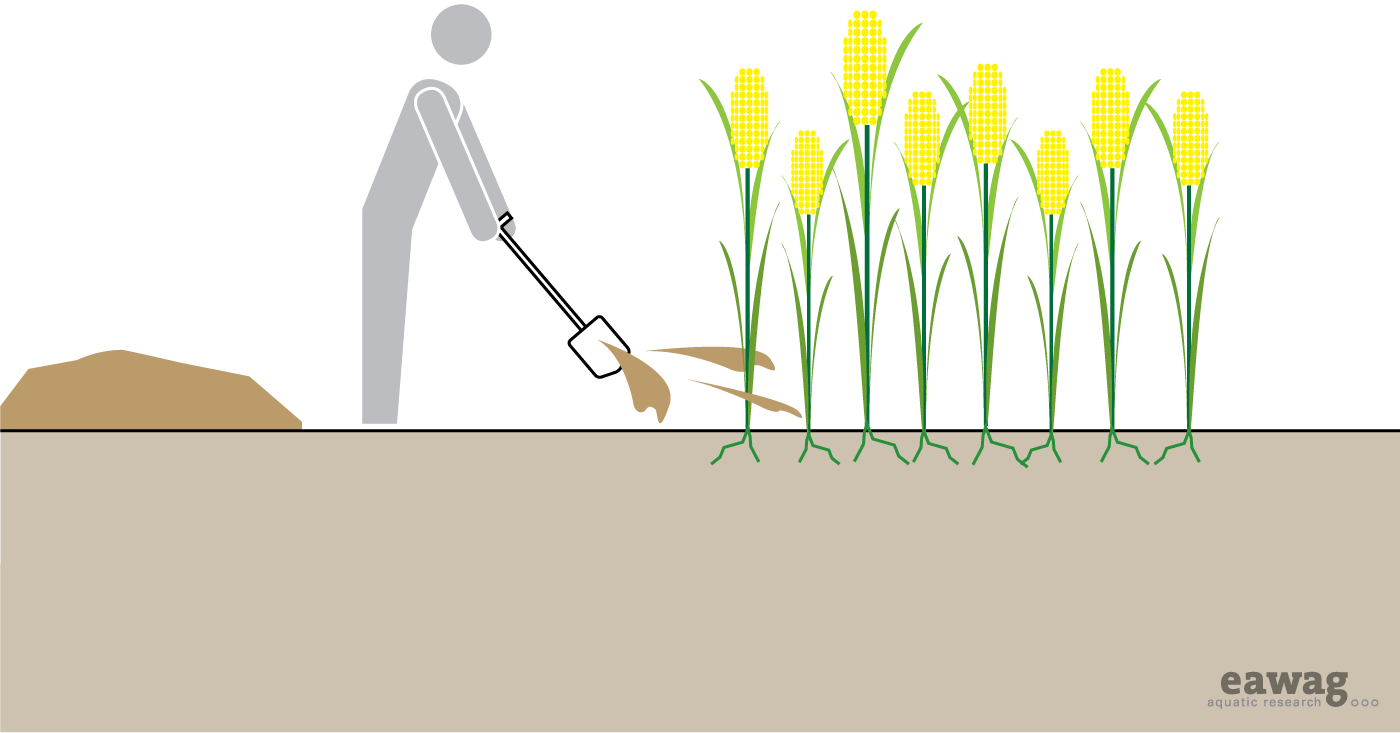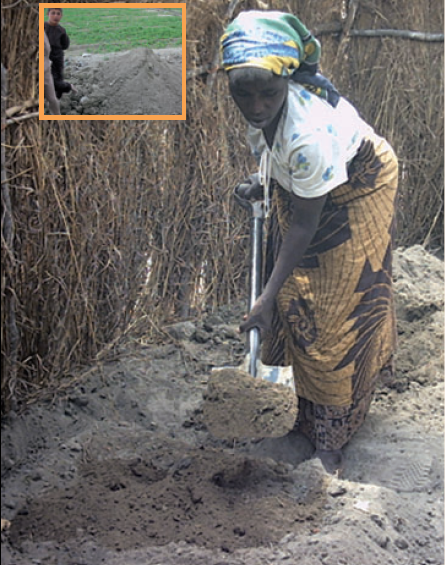Application of Pit Humus and Compost
|

|
|
| |||||||||||||||||||||||||||||||
Decomposed excreta is rich in nutrients (NPK nitrogen, phosphorous, and potassium) and organic material. The organic material in compost acts as soil conditioner. It also improves the structure and water holding capacity of sandy soils and adds structure and permeability to clay soils. Composted excreta, on its own or combined with other biodegradable material, enhances the fertility of topsoil.
Composting is the term used to describe the controlled aerobic degradation of organics into a soil-like substance called compost. ‘EcoHumus’ is a term taken from Peter Morgan (see references) and is a more appropriate word to use for the material removed from a Fossa Alterna because it is produced passively underground and has a slightly different composition.

The process of thermophilic composting generates heat (50 to 80°C) which kills the majority of pathogens present. For the composting process to occur there must be adequate carbon, nitrogen, moisture, and air. The Fossa Alterna and Arborloo are ambient temperature variations of high-temperature composting. In these technologies, there is almost no temperature rise because vegetable matter is lacking. For that reason, the end material is not actually ‘compost’ and is therefore referred to as ‘EcoHumus’.
The WHO guidelines state that the compost should achieve and maintain a temperature of 50°C for at least one week before it is considered safe (although to achieve this value, a significantly longer period of composting is required). The WHO guidelines should be consulted for detailed information. For systems that generate EcoHumus in-situ (i.e. Fossa Alterna), a minimum of 1 year of storage is recommended to eliminate bacterial pathogens and reduce viruses and parasitic protozoa.
Compost/EcoHumus can be used beneficially to improve the quality of soils by adding nutrients and organics and improving the soil’s ability to store air and water. The texture and quality of the EcoHumus depends on the materials, which have been added to the excreta (especially the type of soil).
| Advantages | Disadvantages/limitations |
|---|---|
| - Potential income generation (improved yield and productivity of plants). - Low risk of pathogen transmission. - Can improve soil conditions such as the structure and water-holding capacity of soil. Compost reduces the need for artificial fertilizer. - Simple technique for all users. - Low cost. |
- Requires a year or more of maturation. - Does not replace fertilizer (N, P, K). -Cultural taboos could hinder use. -Health precautions always need to be considered when applying compost enriched with excreta. |
Adequacy
Compost/EcoHumus can be mixed into the soil before crops are planted, used to start seedlings or indoor plants or simply mixed into an existing compost pile for further treatment.
For poor soils, equal parts of compost and top soil have shown to improve productivity. The output from one Fossa Alterna should be sufficient for two 1.5m by 3.5m beds. Vegetable gardens filled with the Eco- Humus from the Fossa Alterna have shown dramatic improvements over gardens planted without compost, and has even made agriculture possible in areas which would have not otherwise supported crops.
Health Aspects/Acceptance
A small risk of pathogen transmission exists, but if in doubt, any material removed from the pit can be composted further in a regular compost heap, or mixed with additional soil and put into a ‘tree pit’, i.e. a nutrient-filled pit used for planting a tree.
Compost containing excreta should be applied in such a way that the upper layer of the soil covers the material. Note; compost from excreta should not be applied as fertilizer to vegetables eaten raw.
As opposed to sludge, which originates from a variety domestic, chemical and industrial sources, compost has very few chemical inputs. The only chemical sources that could contaminate compost might originate from contaminated organic material (e.g. pesticides) or from chemicals that are excreted by humans (e.g. medication). Compared to the cleaning, pharmaceutical and processing chemicals that may find their way into sludge, compost can be considered as a less contaminated product.
Acceptability may be low at first, but demonstration units and hands-on experience are effective ways of demonstrating the non-offensive nature of the material.
Maintenance
The material must be allowed to mature adequately before it is removed from the system and then it can be used without further treatment.
External Links
- General information about Compost as soil conditioner www.ecosanres.org
Acknowledgements
The material on this page was adapted from:
Elizabeth Tilley, Lukas Ulrich, Christoph Lüthi, Philippe Reymond and Christian Zurbrügg (2014). Compendium of Sanitation Systems and Technologies, published by Sandec, the Department of Water and Sanitation in Developing Countries of Eawag, the Swiss Federal Institute of Aquatic Science and Technology, Dübendorf, Switzerland.
The 2nd edition publication is available in English. French and Spanish are yet to come.
References and external links
- Del Porto, D. and Steinfeld, C. (1999). The Composting Toilet System Book. A Practical Guide to Choosing, Planning and Maintaining Composting Toilet Systems, an Alternative to Sewer and Septic Systems. The Center for Ecological Pollution Prevention (CEPP), Massachusetts, USA.
- Jenkins, J. (1999). The Humanure Handbook: a Guide to Composting Human Manure. (2nd ed.). Jenkins Publishing, Grove City, Pa, USA. Available: http://www.jenkinspublishing.com
- Morgan, P. (2004). An Ecological Approach to Sanitation in Africa: A Compilation of Experiences. Aquamor, Harare, Zimbabwe. Available: http://www.ecosanres.org
- Morgan, P. (2007). Toilets that make compost. Stockholm Environment Institute, Stockholm, Sweden. pp 81–90. Available: http://www.ecosanres.org
- NWP (2006). Smart Sanitation Solutions. Examples of innovative, low-cost technologies for toilets, collection, transportation, treatment and use of sanitation products. Netherlands Water Partnership, The Netherlands. pp 49.

